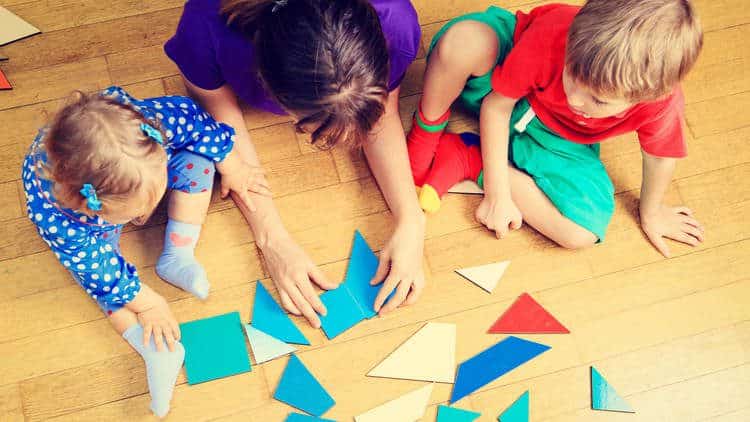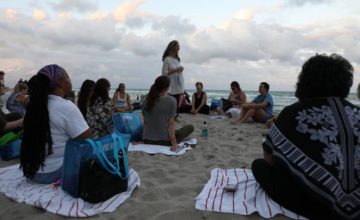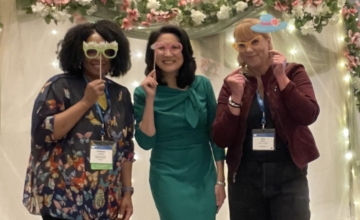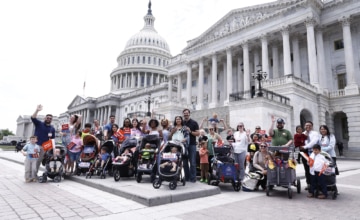Early numeracy skills, like early literacy, are an important component of school readiness efforts and are an everyday part of even very young children’s lives.
Although definitions of numeracy vary, it is typically understood to mean “the ability to use appropriate mathematical knowledge, …skills,… and experience whenever they are needed in everyday life” (Department of Education of the Arts in Perry, 11). Early numeracy skills, like early literacy, are an important component of school readiness efforts and are an everyday part of even very young children’s lives.
Early mathematical concepts and skills—those which the first-grade mathematics curriculum builds upon—include those listed below (Bowman, B. T., Donovan, M. S., & Burns, M. S., (Eds.), 2001, 76).
- Recognition of size, shape, and patterns
- Ability to count verbally (first forward, then backward)
- Recognition of numerals
- Ability to identify more and less of a quantity
- Mastery of one-to-one correspondence (i.e., matching sets, or knowing which group has four and which has five)
To achieve these skills requires competency in the four keystones of mathematical literacy listed below (Diezmann and Yelland, 2000, pp. 49-52):
- Representation—finding ways to express mathematical concepts with words, diagrams, pictures, symbols and manipulatives (like blocks)
Casey (aged 3) was making piles of sunflower seeds. When asked why, he explained: “We need 5 seeds for each kid. I’m helping!” - Performing Mathematical Manipulations—utilizing the appropriate calculations and procedures, using the information given to answer the question posed
Yvette (28 months) and Charlotte (30 months) were standing in the center’s outside play area and crying. When their caregiver, Julia, came over to see why, Yvette explained: “No trikes!” Julia watched several children zooming around on tricycles. “Hmmmm, we need more trikes, you’re right. How many more?” Yvette shouted, “One for me and one for Charlie!” Julia said, “That’s right. We need 2 trikes for you and Charlie. Let’s see if anyone is done riding them yet.” - Reasoning—assessing a problem using facts, properties and relationships to make and test conjectures, develop logical arguments, and identify a useful answer.
Carl (aged 9 months) looked at the toy his early interventionist brought that day. It was a plastic drum with 3 holes in the top. The holes were in the shape of a triangle, a circle and a square. Carl looked at the blocks surrounding him. They, too, were different shapes. Carl picked up a triangular block. He put it in his month, then banged it on the floor. He touched the edges with his fingers. Then he tried to stuff it in each of the holes of the new toy. Surprise! It fell inside the triangle hole! Carl reached for another block, a circular one this time… - Problem solving—thinking through an issue, using prior knowledge and skills to reach and validate a solution (and realizing more than one solution may exist). Posing one’s own problems.
Jennie (aged 18 months) was given a bag of crackers. “Give everybody one,” her caregiver, Teri, said. Jennie gave each child at the table a cracker. But there was one left over. “What should we do with the extra cracker?” asked Teri. Jennie stopped and thought. Then she opened her mouth and popped it in!
Here, numeracy, language and social skills come together. In all of the competencies above, children’s ability to communicate effectively and express their ideas is integral to success with a given mathematical problem—whether it comes up in play (only five children may be in the blocks area at once) or in a more structured setting. Early numeracy experiences provide ample opportunities to develop and extend children’s vocabulary and literacy skills.
Even very young children’s social environments include access to counting systems (how many steps are we walking up?), as well as exposure to principles of one-to-one correspondence (are there enough cookies for each child?) (Bowman, B. T., et al., 2001, p. 201). Prior to entering school, most children develop an innate understanding of addition and subtraction through everyday interactions (Thomas has two shovels; Joseph wants one; after this transaction, Thomas sees that he has one left) (Bowman B. T. et al., 2001, p. 201). This learning occurs at home as well, where parents introduce important numerical concepts through everyday interactions. For example, young children learn that money has a value when they are denied a toy deemed “too expensive.” Family members and other adults support children’s number learning through songs like “One Two, Buckle My Shoe” and stories like “The Three Bears.” This informal foundation in mathematics, forged during very young children’s prior-to-school years, provides a rudimentary conceptual framework from which formal instruction can begin.
The tips below highlight ways that staff members can build upon the natural curiosity of very young children to establish a solid foundation of early numeracy skills. (Note: Most of these tips are designed for older children—ages 2-3. Younger children can be exposed to stories and songs using repetition, rhymes and numbers. Staff, parents and caregivers should also speak to children about mathematical concepts (e.g., “That’s a great big dog! He’s bigger than our cat, isn’t he?”) even though babies don’t yet understand.
Promoting Early Numeracy Skills in Infant/Family Programs
- Help children learn their own address and phone number. Talk with them about how buildings are numbered, how their house or apartment is one of a series, each with its own number.
- Use dress-up time as an opportunity to talk about relative sizes (“the red dress is bigger than the green dress”) as well as to help children begin to think about their own size relative to other objects (“will that policeman’s jacket fit you, do you think?”).
- Home visitors (and center-based staff) can use cooking as a way to introduce mathematical concepts. Even young children can be helped to fill, stir, and pour—through these activities, children learn to count, measure, divide, and estimate.
- Taking a walk gives children many opportunities to compare (“which leaf is bigger?”), assess (“how many leaves does that branch have?”), note similarities and differences (“does the bunny live in the tree? Does the bird?”) and categorize (“see if you can find all the red leaves”).
- Use an hourglass or timer to time activities. This helps children develop a sense of time and to understand that some things take longer than others.
- Point out the different shapes and colors you see during the day. On a walk, you may see a triangle-shaped sign that’s yellow. Inside you may see a rectangle-shaped sign that’s red.
- Sing songs that rhyme, repeat, or have numbers in them. Songs reinforce patterns (which are tools that help in problem-solving because they tell us what to expect next). They also are fun ways to practice language and mathematics.
- Use a calendar. Talk to children about what day it is, what the different days of the week are, and what they can expect the next day.
- Ask for children’s help in distributing items to class members. Requests like “Give one to each child” helps children understand one-to-one correspondence. When you are distributing items, emphasize the number concept: “One for you, one for me, one for Raul.”
- Ask children to sort crayons and markers into containers (or use buttons, pasta, leaves, shells, etc.).
- Provide children with lots of open-ended play with blocks, empty boxes, milk cartons, etc. Stacking and manipulating these toys help children to learn about shapes and the relationships among shapes (e.g., two triangles make a square). Nesting boxes for younger children help them to understand the relationships between different sized objects.
- Give children a cardboard box or tunnel to climb through. This helps them understand their body in space (this is called “spatial relations”).
- Hang pieces of yarn and ask which is the longest and shortest. Have kids arrange the yarn from longest to shortest.
- Pass a shape around and have children look at it and feel it with eyes open and closed.
- Help children practice patterns by stringing beads, making block patterns, or making a pattern with two napkins at snack time.
References:
- Bowman, B. T., Donovan, M. S., & Burns, M. S., (Eds.). (2001). Eager to learn: Educating our preschoolers. Washington, DC: National Academy of Sciences.
- Diezmann, C., & Yelland, N. J. (2000). Developing mathematical literacy in the early childhood years. In Yelland, N. J. (Ed.), Promoting meaningful learning: Innovations in educating early childhood professionals. (pp.47-58). Washington, DC: National Association for the Education of Young Children.
- Perry, B. (1998/1999). Early childhood numeracy. Canberra: Commonwealth of Australia. Available at: http://www.aamt.edu.au/NUMERACY/PERRY.PDF




